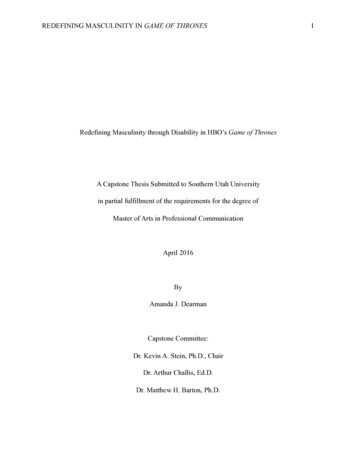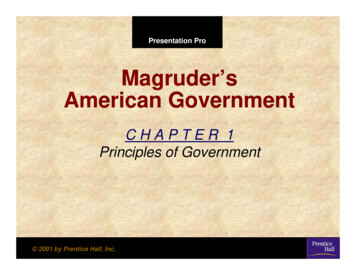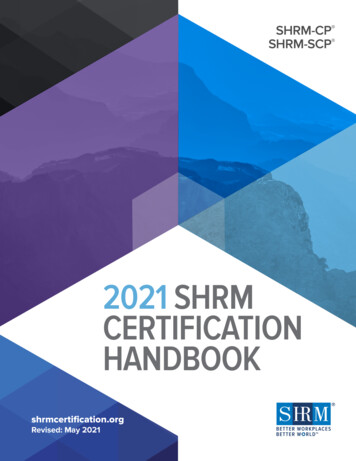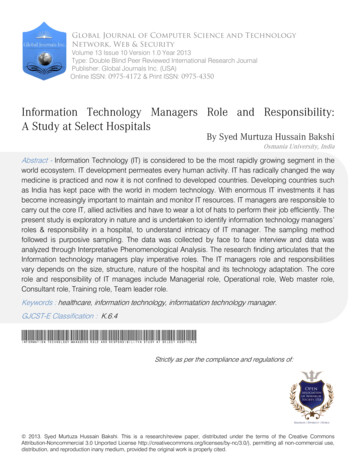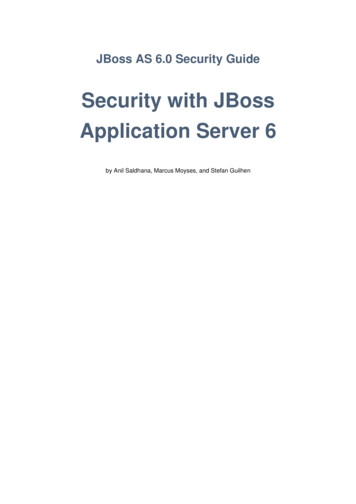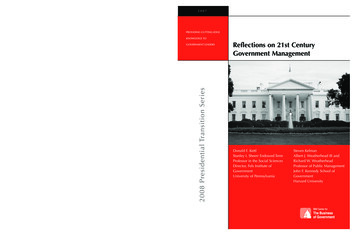
Transcription
Redefining the Role of GovernmentActivities in Automated TruckingJanuary 2020
Redefining the Role of Government Activities inAutomated TruckingJanuary 2020Dan MurraySenior Vice PresidentAmerican Transportation Research InstituteMinneapolis, MN950 N. Glebe Road, Suite 210Arlington, Virginia 22203TruckingResearch.org
ATRI BOARD OF DIRECTORSJudy McReynoldsChairman of the ATRI BoardChairman, President and ChiefExecutive OfficerArcBest CorporationFort Smith, ARAndrew BoyleCo-PresidentBoyle TransportationBillerica, MAHugh EkbergPresident and CEOCRST International, Inc.Cedar Rapids, IADarren D. HawkinsChief Executive OfficerYRC WorldwideOverland Park, KSDave HuneryagerPresident and CEOTennessee Trucking AssociationNashville, TNDerek LeathersPresident and CEOWerner EnterprisesOmaha, NERobert E. LowPresident and FounderPrime Inc.Springfield, MORich McArdlePresidentUPS FreightRichmond, VABenjamin J. McLeanChief Executive OfficerRuan Transportation ManagementSystemsDes Moines, IADennis NashExecutive Chairman of the BoardKenan Advantage GroupNorth Canton, OHJames D. ReedPresident and CEOUSA TruckVan Buren, ARAnnette SandbergPresident and CEOTranssafe Consulting, LLCDavenport, WAJohn A. SmithPresident and CEOFedEx FreightMemphis, TNRebecca BrewsterPresident and COOATRIAtlanta, GAChris SpearPresident and CEOAmerican Trucking AssociationsArlington, VA
ATRI RESEARCH ADVISORY COMMITTEEKaren Rasmussen, RACChairmanChief Executive OfficerPrePass Safety AllianceMichael AhartVP, Regulatory AffairsOmnitracs LLCThomas A. Balzer, CAEPresident and CEOOhio Trucking AssociationShawn R. Brown, CDSVice President of SafetyCargo TransportersKenneth CalhounFleet Optimization ManagerAltec Service GroupAlison Conway, Ph.D.Assistant ProfessorThe City College of New YorkRobert P. CostelloChief Economist and SeniorVice President,International Trade Policy andCross-Border OperationsAmerican TruckingAssociationsDan DrellaDirector, Safety and TrainingSchneider National, Inc.James P. FieldsChief Operating OfficerPitt-Ohio, LLCVictoria KingVP, Public AffairsUPSJames LangleyPresidentTrimble TransportationStephen LaskowskiPresidentCanadian Trucking AllianceDon LefevePresident and CEOCommercial Vehicle TrainingAssociationKevin LhotakPresidentReliable TransportationSpecialistsMike LudwickBison TransportChief Administrative OfficerDouglas B. Marcello, EsqTransportation AttorneyMarcello & Kivisto, LLCJaime MausVice President of Safety andComplianceWerner Enterprises, Inc.Steven RaetzDir. Research & MarketIntelligenceC.H. Robinson Worldwide, Inc.Jeremy ReymerFounder and CEODriverReachLee SarrattDirector of SafetyJ.B. HuntMark SavageDeputy ChiefColorado State PatrolKary SchaeferGeneral Manager of Marketingand Strategy for Freightlinerand Detroit BrandsDaimler Trucks North America,LLCRuss SimpsonAmerica’s Road Team CaptainHollandCaroline MaysDirector, Freight andInternational Trade SectionTexas DOTMike StephensVice President of FinanceUSA Truck, Inc.Shannon NewtonPresidentArkansas Trucking AssociationCollin StewartPresident and CEOStewart Transport, Inc.Steve OlsonPresident and ChiefUnderwriting OfficerGreat West Casualty CompanySara WalfoortManager, Freight PlanningSouthwestern PennsylvaniaCommissionHolly PixlerSenior Director Transportation,Warehousing and InternationalMillerCoorsTom WeakleyDirector of OperationsOwner-Operator IndependentDrivers Association FoundationJohn PrewittPresidentTideport Distributing, Inc.Shawn YadonChief Executive OfficerCalifornia Trucking Association
TABLE OF ACRONYMSADASAAMVAAASHTOATRIATAAUTO-ISACADSATAVAV 2.0AV 3.0AV CICNHTSANISTODDOEMPHMSASAETMCU.S. DOCU.S. DOTOSTV2XV2IV2VVSSA1Advanced Driver Assistance SystemsAmerican Association of Motor Vehicle AdministratorsAmerican Association of State Highway and Transportation OfficialsAmerican Transportation Research InstituteAmerican Trucking AssociationsAutomotive Information Sharing and Analysis CenterAutomated Driving SystemsAutonomous TrucksAutonomous Vehicles“Automated Driving Systems 2.0: A Vision for Safety”"Preparing for the Future of Transportation: Automated Vehicles 3.0"“Ensuring American Leadership in Automated Vehicle Technologies: AutomatedVehicles 4.0”Cellular V2XCommercial Driver’s LicenseCommercial Motor VehicleCommercial Vehicle Safety AllianceDedicated short-range communicationsDepartment of Homeland SecurityDifferential Global Positioning SystemElectronic Logging DeviceFederal Communications CommissionFederal Highway AdministrationFederal Motor Carrier Safety AdministrationFederal Motor Carrier Safety RegulationsFederal Motor Vehicle Safety StandardsFederal Trade CommissionFully Autonomous VehicleGlobal Positioning SystemGross Vehicle WeightHighly Automated VehicleHours-of-ServiceInformation Sharing and Analysis CenterInstitute of Electrical and Electronics EngineersInternational Organization for StandardizationManual on Uniform Traffic Control DevicesNational Association of City Transportation OfficialsNational Conference of State LegislaturesNational Cybersecurity and Communications Integration CenterNational Highway Traffic Safety AdministrationNational Institute of Standards and TechnologyOperational Design DomainOriginal Equipment ManufacturersPipeline and Hazardous Materials Safety AdministrationSociety of Automotive EngineersTechnology & Maintenance CouncilU.S. Department of CommerceU.S. Department of TransportationU.S. Department of Transportation Office of the ctureVehicle-to-VehicleVoluntary Safety Self-AssessmentRedefining the Role of Government Activities in Automated Trucking
TABLE OF CONTENTSRESEARCH OBJECTIVE . 4INTRODUCTION . 5FEDERAL GUIDANCE . 6Legislation . 6Regulatory Jurisdictions and Roles . 8United States Department of Transportation (U.S. DOT). 8National Highway Traffic Safety Administration (NHTSA). 10Federal Motor Carrier Safety Administration (FMCSA) . 11Federal Highway Administration (FHWA) . 13AV Policy Issues . 13Cooperative Automation and Connectivity . 13Pilot Testing and Proving Grounds . 15Cybersecurity . 17Data Privacy . 19Implications of Enforcement and Human Interaction . 20Technical Standards . 20STATE AND LOCAL ACTION . 24Best Practices. 24State Legislatures . 24State and Local Safety Guidance . 25State Policy Progress Report. 27Definitions . 27Regulatory Hierarchy . 29Licensing and Registration . 30Insurance and Liability . 31Data Privacy and Cybersecurity . 32Operator Requirements . 34Current Status of AV Testing and Operations on Public Roadways . 35CONCLUSION . 38APPENDIX A: TIMELINE OF DOT REGULATORY ACTIONS ON TRUCKING AV . 40APPENDIX B. AUTOMATED VEHICLE REGULATION BY STATE . 42Redefining the Role of Government Activities in Automated Trucking2
FIGURES AND TABLESTable 1. U.S. DOT and U.S. DOC Roles in Proposed AV Legislation . 7Table 2. Benefits and Challenges of U.S. DOT Policies in AV 3.0 . 9Figure 1. States Hosting or Planning AV Pilot Tests. 15Figure 2. SAE J3016 Automated-Driving Levels . 16Table 3. Cybersecurity Recommendations to AV Manufacturers / Developers . 18Table 4: Technology that Enables Automation in Trucking . 21Table 5: Key Terminology and Concepts for AV Policy . 28Figure 3. Current Status of Policy on AV Testing and Operation . 36Figure 4: Current Status of Policy on Truck Platooning Testing and Operation . 373Redefining the Role of Government Activities in Automated Trucking
RESEARCH OBJECTIVEIn 2018, the American Transportation Research Institute (ATRI) Research AdvisoryCommittee (RAC) 1 ranked the “Role and Impact of Government Regulations onAutonomous Vehicles” as one of its top research priorities. At the time, federalleadership relating to the safe integration of autonomous trucks (AT) was lacking, whilenumerous states were developing disparate regulatory frameworks from piecemeallegislation and executive orders. Recognizing the inconsistent regulatory frameworkthat existed for ATs, the RAC asserted that both public- and private-sector truckingindustry stakeholders would benefit from an analysis of existing and emerging ATpolicies and regulations – with the intent of identifying “best practices” for facilitating thesafe and efficient development and adoption of AT technologies.In late 2018, the U.S. Department of Transportation (U.S. DOT) released a publicationof “Preparing for the Future of Transportation: Automated Vehicles 3.0” (AV 3.0). ThisU.S. DOT document, which precedes the Automated Vehicles 4.0 released on January7, 2020, a is comprehensive federal effort to define regulatory roles, identify legislativeneeds, and chart the road ahead for implementing these technologies acrosstransportation modes, yet the state and local AT activities are still disparate. 2 Inresponse to the RAC’s priority and this more recent federal guidance, this research hastwo main objectives:1) Analyze the state and federal regulatory framework to identify the policy areasand regulatory roles necessary to promote the development and adoption of ATsin the trucking industry; and2) Juxtapose the current status of trucking-specific legislation and regulationproposed or adopted across states with the trucking industry’s AT needs.To accomplish these objectives, this report assesses AT regulations, leverages insightfrom public- and private-sector officials, and seeks to identify policy and regulatoryopportunities for developing, testing, and adopting AT technologies in the truckingindustry.1ATRI’s Research Advisory Committee is comprised of industry stakeholders representing motor carriers, truckingindustry suppliers, labor and driver groups, law enforcement, federal government, and academics. The RAC ischarged with annually recommending a research agenda for the Institute.2 “Preparing for the Future of Transportation: Automated Vehicles 3.0.” U.S. Department of Transportation. October2018. Washington, D.C. Available online: https://www.transportation.gov/av/3.Redefining the Role of Government Activities in Automated Trucking4
INTRODUCTIONThe rapid pace of autonomous vehicle (AV) development has the potential to affectmany aspects of trucking industry operations. Original equipment manufacturers(OEM), technology firms and software developers are actively developing a variety ofAT applications for the trucking industry. While most emerging AT systems incorporatesome combination of LIDAR, RADAR and camera variations, well established advanceddriver assistance technologies, including active lane keeping and automatic emergencybraking systems, are moving forward more quickly. These advanced driver assistancesystems (ADAS) are commercially available to motor carriers on newer truck models,while the development, testing, and validation of highly- and fully-automated drivingsystems is ongoing. 3 To minimize confusion between ADAS and the automated drivingsystems (ADS) closely associated with autonomous vehicles, this report will use“autonomous vehicle” or “AV” in reference to both AV and ADS.While both Congress and the American Association of State Highway andTransportation Officials (AASHTO) are separately pursuing a national vision, no oneappears to be developing a comprehensive roadmap for fostering all of these emergingtechnologies in the trucking industry. As noted, trucking applications had been absentfrom the federal AV legislation introduced until recently, 4 with the U.S. DOT onlypublishing its first Departmental policy statement on trucking-related automation withinthe last 18 months. 5 Although the U.S. DOT notes that “ current safety standards donot prevent the development, testing, sale, or use of ADS built into vehicles thatmaintain the traditional cabin and control features of human-operated vehicles,” truckingindustry stakeholders believe the slow pace of federal leadership and guidance hasallowed states to implement an incomplete patchwork of regulations through piecemeallegislation and executive action. This, in turn, has likely hindered the development andadoption of AV and ADAS technologies in the trucking industry. ADAS technologies arelikely to move forward even more quickly with the October 2019 announcement thatFMCSA would be funding a new national ADAS research program. 6 The impact ofexpedited ADAS development, however, makes the near-term future of AT morespeculative as industry resources and testing are likely to be redirected.Given the disparate and slow-to-start status of federal and state responses to emergingAV technologies in trucking, major policy questions and regulatory roadblocks have notbeen thoroughly addressed. This research analyzes the ongoing changes andchallenges associated with these technologies in the trucking industry, particularly in thecontext of relevant policy areas and regulatory jurisdictions.3Slowik, P., and Sharpe, B. “Automation in the long haul: Challenges and opportunities of autonomous heavy-dutytrucking in the United States.” The International Council on Clean Transportation. Working Paper 2018-06. March2018.4 Mulero, E. “Federal Standards on Autonomous Vehicle Technology Is Needed, Rep. Latta Says.” TransportTopics. September 13, 2018. Available online: 5 “Preparing for the Future of Transportation: Automated Vehicles 3.0.” U.S. Department of Transportation. October2018. Washington, D.C. Available online: https://www.transportation.gov/av/3.6 Lamb, E. “FMCSA Announces Joint Program To Advance Driver Assist Technology.” Transport Topics. October 6,2019. Pg 4.5Redefining the Role of Government Activities in Automated Trucking
FEDERAL GUIDANCEDespite continued advances in the private development of AV and connected vehicletechnologies for commercial motor vehicles (CMV), 7 the United States Congress andthe U.S. DOT have not yet developed legislation or formalized policies facilitating theiradoption. While Congress has not yet passed comprehensive legislation governing AVdevelopment in either passenger or commercial vehicles, in the fall of 2019, thechairman of the Senate panel with jurisdiction over freight affairs confirmed that afederal regulatory framework for AT vehicles is being drafted by Congress. 8 Venturecapital investments in AV are substantial – in 2018 more than 10 billion poured into146 AV deals worldwide. However, momentum appears to be slowing; in the first twoquarters of 2019, only 3.2 billion in 64 deals were documented. 9 If congressionalaction manifests quickly, AT development may again increase.LegislationCongress initially commenced development of two bills related to passenger vehicle 10applications of these technologies. Industry stakeholders attempted to expand CMVrelated components of the SELF DRIVE Act in the House of Representatives and AVSTART Act in the Senate as it would relate to the development, testing, andimplementation of these technologies. 11,12While the bills were not ultimately raised for passage, a common theme present in bothdraft bills was the emphasis on preempting states from enacting laws relating to AVtechnologies that differ from federal standards. The SELF DRIVE Act would have preempted “states from enacting lawsregarding the design, construction, or performance of” AV technologies “unlesssuch laws enact standards identical to federal standards.” 13 The AV Start Actwould have preempted “states from adopting, maintaining, or enforcing any law,rule, or standard regulating” AV technologies “regarding certain safety evaluationreport subject areas.”147 Slowik, P. and B. Sharpe. “Automation in the long haul: Challenges and opportunities of autonomous heavy-dutytrucking in the United States.” The International Council of Clean Transportation. Working Paper 2018-06. March26, 2018.8 Mulero, E. “Congressional Policymakers Drafting Autonomous Vehicles Bill.” Transport Topics. November 20, 2019.Available online: cymakers-drafting-autonomous-vehicles-bill9 Pitchbook AV Investment Report, August, 2019. Available online: rs-in-autonomous-vehicle-tech10 Vehicles with a gross vehicle weight of 10,000 pounds or less.11 H.R.3388 – SELF DRIVE Act. 115th Congress (2017-2018). September 7, 2017. Available s/house-bill/3388.12 S.1885 – AV START Act. 115th Congress (2017-2018). November 28, 2018. Available s/senate-bill/1885.13 H.R.3388 – SELF DRIVE Act. 115th Congress (2017-2018). September 7, 2017. Available s/house-bill/3388.14 S.1885 – AV START Act. 115th Congress (2017-2018). November 28, 2018. Available s/senate-bill/1885.Redefining the Role of Government Activities in Automated Trucking6
Most AV advocates emphasize that federal preemption of state law is of criticalimportance to applications of AV in trucking, particularly in the context of deployingthese technologies in interstate commerce. Due to the complexity of navigating arounda patchwork of state laws in interstate commerce, the potential use cases for AVtechnologies could be limited to local or regional operations in locations with favorableregulatory frameworks. More specifically, a fragmented regulatory landscape acrossstates will hinder their deployment in interstate trucking where the potential is highest forhighly automated technologies to handle operations on long stretches of interstate.The AV START and SELF DRIVE Acts also attempted to define several roles andresponsibilities that could fall under the jurisdiction of the U.S. DOT, while the AVSTART Act also carved out a role for the U.S. Department of Commerce (U.S. DOC).The roles and responsibilities for these government agencies that could potentiallyaffect AV applications in trucking are described in Table 1.Table 1. U.S. DOT and U.S. DOC Roles in Proposed AV LegislationU.S. SenateAV START ActU.S. House ofRepresentativesSELF DRIVE ActU.S. DOT Establish a technical committee on AV safety. Establish a working group on ADS educationefforts. Research the traffic safety implications of AVs. Require safety assessmentcertifications for thedevelopment of AV. Inform prospective buyers ofAV of vehicle capabilities andlimitations. Research updated safetystandards for motor vehicleheadlamps.U.S. DOC Establish the Highly Automated Vehicle (HAV)Access Advisory Committee to discuss andmake policy recommendations relating to thedata that vehicles collect, generate, record, orstore electronically. Develop educational cybersecurity resourcesto assist consumers in minimizingcybersecurity risks. Study the impacts of HAVs on infrastructure,mobility, the environment, and fuelconsumption. Study ways to encourage U.S. manufacturingof AV. N/AAgency7Redefining the Role of Government Activities in Automated Trucking
Regulatory Jurisdictions and RolesThe National Highway Traffic Safety Administration’s (NHTSA) publication of“Automated Driving Systems 2.0: A Vision for Safety” (AV 2.0)15 and the U.S. DOT’ssubsequent publication of AV 3.0 serve as the most comprehensive federal guidanceissued to-date on regulatory jurisdictions and roles. However, the policy guidanceissued on the roles of the U.S. DOT’s surface transportation operating administrationslargely remains at a high-level, and in most instances, has not yet resulted in formalizedpolicy and action.In early January 2020, the U.S. DOT published their fourth iteration of the autonomousvehicle report, entitled, “Ensuring American Leadership in Automated VehicleTechnologies: Automated Vehicles 4.0” (AV 4.0). This report is meant to “informcollaborative efforts in automated vehicles” and “outline past and current FederalGovernment efforts” to address AV technology. 16U.S. DOTThe U.S. DOT’s role in transportation automation is focused on “ensuring the safety andmobility of the traveling public while fostering economic growth;” as such, theDepartment will be an essential stakeholder in integrating AV technologies on U.S.roadways. 17 Additionally, the U.S. DOT seeks to be technology-neutral as it supportsprivate, market-oriented AV innovations that benefit the U.S. workforce and enhancesafety, mobility, and economic opportunity. The guiding policies that the U.S. DOTdefines in AV 3.0 to fulfill this mission are summarized in Table 2, with a particularemphasis on how they could positively or negatively impact the adoption of AVtechnologies in trucking.To date, the AV policy and regulatory development process has been iterative andmulti-faceted (Appendix A). While numerous government agencies have been involvedin the development of AV 2.0, 3.0 and now 4.0, there is a growing need to streamlineand centralize the activities and authorities. As an important next step in policy andregulatory development, the U.S. DOT should develop and promulgate “recommendedpractices” in the form of model legislation for states and municipalities.15 “Automated Driving Systems 2.0: A Vision for Safety.” U.S. DOT National Highway Transportation SafetyAdministration. September 2017. Washington, D.C. Available online: https://www.transportation.gov/av/2.0.16 “Ensuring American Leadership in Automated Vehicle Technologies: Automated Vehicles 4.0”. U.S. Department ofTransportation. January 2020. Washington, D.C. Available 360956/ensuringamericanleadershipav4.pdf17 “Preparing for the Future of Transportation: Automated Vehicles 3.0.” U.S. Department of Transportation. October2018. Washington, D.C. Available online: https://www.transportation.gov/av/3.Redefining the Role of Government Activities in Automated Trucking8
Table 2. Benefits and Challenges of U.S. DOT Policies in AV 3.0U.S. DOTPolicyBenefitChallengeConduct and SupportAutomation ResearchAddress potential safety risksand advance safety-improvingaspects of AV to strengthenpublic confidence in theseemerging technologies.Remove barriers to innovation.Address market failures andother public needs.Research timelines maystruggle to keep pace with therate of technologicaladvancement.Remain TechnologyNeutralEnsures that the FederalGovernment does notdetermine which entities andtechnologies will benefit fromAV adoption.Complicates the process forcreating and updating technical,infrastructure, and vehiclesafety standards. Will require aflexible approach to formulatingstandards.Modernize RegulationsNecessary for implementing aflexible and adaptable processfor developing AV standards.Discussion of which regulationsrequire updating or eliminationis very limited. Emphasizesvoluntary technical standardsand guidance for vehicle andinfrastructure safety, mobility,and operations.Create a al for avoidingconflicting regulations andtechnical standards acrossstates. Ensures nationalconsistency for interstatecommerce.Contradicted by emphasis onmodernizing regulations bydeveloping voluntary technicalstandards and approaches.Educate the Public onCapabilities/Limitationsof AVBolsters public confidence inthese emerging technologies.A majority of the general publicare wary of AV deployment. 1818Edmonds, Ellen. “Three in Four Americans Remain Afraid of Fully Self-Driving Vehicles.” AAA. March 2019.Available online: lf-driving-cars-survey/.9Redefining the Role of Government Activities in Automated Trucking
One of the most important of these policies is creating a “Consistent Regulatory /Operational Environment.” Toward this end, the U.S. DOT should quickly develop andpromulgate “recommended practices” in the form of model legislation for states andmunicipalities.National Highway Traffic Safety AdministrationNHTSA is tasked with several critical functions that relate directly to the design, testing,and deployment of AV technologies. Through its mission to “save lives, prevent injuries,and reduce economic costs due to traffic crashes, via education, research, safetystandards, and enforcement activity,” NHTSA has assumed a leading role in defining itsregulatory framework as it relates to the safety of these technologies. 19 Specifically,NHTSA’s regulatory responsibilities defined in AV 2.0 include: “Setting Federal Motor Vehicle Safety Standards (FMVSS) for new motorvehicles and motor vehicle equipment ;”“Enforcing compliance with FMVSS;”“Investigating and managing the recall and remedy of non-compliances andsafety-related motor vehicle defects ;” and“Communicating with and educating the public about motor vehicle safetyissues.”As of AV 2.0, NHTSA holds a Voluntary Safety Self-Assessment (VSSA) DisclosureIndex for ADS pertaining to the Society of Automotive Engineers (SAE) automationlevels 3-5. As prescribed in AV 2.0 and supported later in AV 3.0, VSSA reports arerecommended from entities involved in the testing and deployment of ADS to provide anassessment of how they are addressing safety to the public. On NHTSA’s VSSAwebsite, 20 a list of company VSSA disclosures are accessible to the public for betterunderstanding each different AV organization currently testing vehicles with ADS onpublic roads.NHTSA’s role in the context of AV technologies was fleshed out further in AV 3.0, whichstates that the development, testing, sale, or use of AV technologies is allowed undercurrent safety standards in vehicles with the traditional cabin and control features ofhuman-operated vehicles. However, this policy could serve as an impediment to moreadvanced AV applications configured without human controls (i.e. steering wheel,accelerator pedal, brakes, or mirrors). To this end, NHTSA has issued a rule tostreamline the petition that manufacturers and developers must file in order to receive atemporary exemption for new vehicles that do not comply with existing FMVSS. 21 The19 “Automated Driving Systems 2.0: A Vision for Safety.” U.S. DOT National Highway Traffic Safety Administration.September 2017. Washington, D.C. Available online: https://www.transportation.gov/av/2.0.20 “Voluntary Safety Self-Assessment.” U.S. DOT NHTSA. Available online: untary-safety-self-assessment.21 “49 CFR Part 555, RIN 2127-AL97, Temporary Exemption from Motor Vehicle Safety and Bumper Standards.”U.S. DOT National Highway Traffic Safety Administration. December 2018. Available iles/documents/fr notice completeness 2127al97 updating the petitions for exemptions process - final rule oct18 0.pdf.Redefining the Role of Government Activities in Automated Trucking10
impact of this streamlined process can already be seen, as petitions submitted by Nuro,an automated delivery startup, and General Motors, were recently opened for publiccomment. 22NHTSA also acknowledges in AV 4.0 that its current approach to formulating theFMVSS is incompatible with new AV development, as FMVSS has been based on thepresence of a human driver. In the context of the U.S. DOT remaining technologyneutral, a wide variety of technological standards and Operational Design Domains(ODDs) could emerge. 23 As such, lengthy rulemaking procedures, as well as feature- ordesign-specific safety standards, would inhibit the deployment of new AV technologies.Instead, NHTSA is considering, but has not implemented, more flexible approaches tothe formulation of FMVSS such as using performance-oriented stand
AV 4.0 "Ensuring American Leadership in Automated Vehicle Technologies: Automated Vehicles 4.0" C-V2X Cellular V2X . CDL Commercial Driver's License . CMV Commercial Motor Vehicle . CVSA Commercial Vehicle Safety Alliance . DSRC Dedicated short-range communications . DHS Department of Homeland Security


